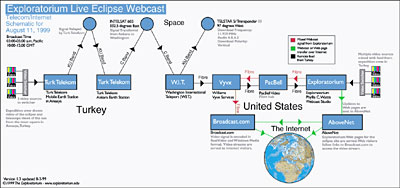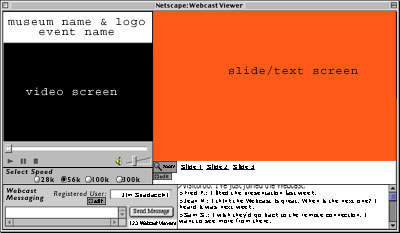![]()
![]()
![]()
![]()
![]()
![]()
![]()
![]()
![]()
![]()
![]()
![]()
![]()
Archives
& Museum Informatics
158 Lee Avenue
Toronto, Ontario
M4E 2P3 Canada
info@ archimuse.com
www.archimuse.com
|
|
Search A&MI |
Join
our Mailing List.
Privacy.
Published: March 15, 2001.

Streaming Audio and Video: New Challenges and Opportunities for Museums
Jim Spadaccini, Ideum, USA
Abstract
Streaming audio and video present new challenges and opportunities for museums. Streaming media is easier to author and deliver to Internet audiences than ever before; digital video editing is commonplace now that the tools -- computers, digital video cameras, and hard drives -- are so affordable; the cost of serving video files across the Internet has also significantly decreased. The initial growth of the World Wide Web was driven by the ease of authoring Web pages, the affordability of the medium, and the potential to reach large audiences. The same conditions are now in place for streaming audio and video, and we're just beginning to see the widespread use of the technology.
The challenges and opportunities presented to museums today are similar to those that existed when the World Wide Web first became popular. Many questions raised are the same: Can this technology be used to expand the museum experience? Are there ways to take advantage of the "two-way" nature of the Internet? A few museums have already experimented with streaming media and some lessons have been learned. However, presentation methods and the technology itself continue to evolve. This paper shares experiences with streaming media (focusing on streaming video), and discusses some possible new directions for effective use of the medium within online museum environments.
Introduction
Ten years ago Apple Computers Inc. released QuickTime, a digital video and animation system. At about the same time the World Wide Web was developed at CERN in Switzerland. These technologies converged in 1995 when the first QuickTime movies appeared on the Web and when the first streaming media format (Real Network's RealAudio) was released. No longer an oddity on the Web, digital video has now become commonplace. Most digital video and audio now developed for the Web is in a "streaming" format, meaning that the entire file or large portions of the file don't need to be downloaded in order for the users to view or listen to its contents.
Streaming Media Drives the Internet
The growth and reach of streaming media continues to hit all-time highs. According to statistics (http://www.Nielsen-NetRatings.com), 35 million Web users accessed streaming content in November of 2000 from their homes. This represents a 65 % increase from November 1999. The same study found that streaming media increased to 36% among all Internet users. This figure compared to a reach of 28% of all Internet users the year before. A November 2000 study by MeasureCast (http://www.measurecast.com) and Harris Interactive (http://www.harrisinteractive.com) found these figures to be even higher, with 57% of online users found to be using streaming media weekly.
Citing ease of use, availability of content, and growth of bandwidth, a study by U.S. Bancorp Piper Jaffray (http://www.piperjaffray.com) suggests that streaming media will be the next "macro-growth driver" on the Internet. The growth of broadband has been well documented. According to Gartner Group's Dataquest Inc. (http://www.dataquest.com), six million US customers signed up for high-speed Internet access in 2000, bringing the total number of broadband users to 11 million. This represents about 9% of all US users. While this is a small percentage overall, it represents significant growth. Last year, according to the Computer Industry Almanac (http://www. c-i-a.com), the figure was a mere 3% of home users.
High-speed Internet access is not essential for streaming media but it does enhance the user's experience. As detailed in "Creating Online Experiences in Broadband Environments" (http://www.archimuse.com/mw2000/papers/spadaccini/spadaccini.html), users get more data throughput, which means better quality video, more frames-per-second, a larger image, better quality audio, and less "lossy" compression. Also, users with a broadband connection (56kbps or faster) are 50% more likely to access streaming media than users with slower (56kbps or slower) connections, this according to Nielsen-NetRatings (http://www.Nielsen-NetRatings.com).
Easier and Cheaper All the Time
The tools for creating streaming media continue to get easier to use and cheaper to purchase. DV video gear, computers, and software are more affordable and easier to use. Many home users and students have begun making their own digital videos. The tools for shooting professional-looking digital video have never been cheaper. A $3,000 camera now has the same resolution that a $30,000 camera had just five years ago. Desktop video systems are commonplace. The success of the iMac and their free iMovie software is a good indication of this trend.
The tools for streaming video, server software in particular, continues to decline in price. This is due in part to competition between three companies: RealNetwork's RealMedia was the standard until in the last two or three years, Microsoft's Windows Media and Apple's streaming QuickTime entered the market. Microsoft's server software is now built into Windows 2000 and Apple's QuickTime Streaming Server is included in the Mac OS X Server. Both of these products cost less than $1,000.
In addition, the number of ISPs (Internet Service Providers) who offer streaming media services continues to expand. Bandwidth costs have declined and competition has eroded the cost of delivering streams to Web visitors. All of these trends take streaming media out of the experimental realm. Even with its limitations (small window size, poor video quality), streaming media is quickly becoming a viable way to reach Internet audiences.
Museum Visitors
Specific information about museum Web visitors is difficult to find since the medium is still so new. The only study examining connection speed and streaming media is "Who's Out There? A Pilot User Study of Educational Web Resources by the Science Learning Network (SLN)" (http://www.archimuse.com/mw2000/papers/semper/semper.html ) found that "a significant percentage of visitors (14 to 22%) now have access at speeds faster than 56k." While this study used a small sampling--about 50,000 visitors over a one-month period--it did study three different Web sites: The Exploratorium, The Franklin Institute, and Science Museum (NMSI) in London.
About 22% of visitors accessed these museum resources from school and about 10% visited the sites from work environments. It's likely that a larger percentage of these visitors were accessing with high-speed connections. This might help explain the discrepancy between the broadband figures from the Gartner Group's Dataquest Inc. study, that found 9% of users connecting at 56kbps or greater, and the figures from the SLN Pilot User Study.
The SLN Pilot User Study also asked visitors whether they viewed one or more multimedia clips: 23% stated they did. While it's difficult to draw too many conclusions from this one figure taken from only three resources (and considering that only two of the three resources contained streaming media), it's at least an indication that a significant percentage of museum Web visitors were actively interacting with streaming media in 1999. So that from this somewhat limited data, one could infer that the number of Web visitors to museums who can access streaming media continues to grow (as it certainly has in the general Internet population).
Expanding the Museum Experience
The complex question of how to present streaming video remains. Obviously, the answers are subjective. Streaming media can be presented either live, or more commonly, on demand. Each type of streaming media requires different presentation methods to effectively reach Web audiences. On-demand video has offered much more variety, while most museum Webcasts have been presented in very straightforward ways, with the developers concentrating on the more complex technical and programmatic aspects of producing and delivering the live video stream.
On Demand
In early 1997, while working at the Exploratorium, the author developed a resource called "The Science of Hockey" (http://www.exploratorium.edu/hockey), the first in a series of sport science Websites developed over the next two years. Permission was granted to interview local professional hockey team, the San Jose Sharks. It was perfect timing as the first streaming video format, RealVideo, had just been released.
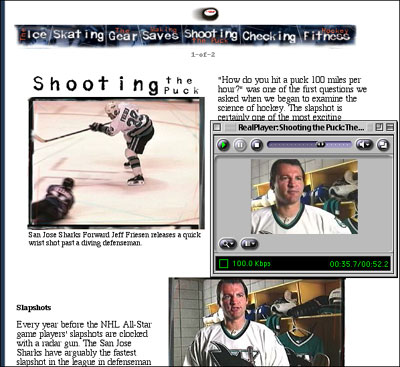
Figure 1. The Science of Hockey
There was no question that the video had to be presented within the context of a text- and image-based site. This had little to do (in the thinking at the time) with creating a context for the video, but rather the reality that most users would not have the technical equipment to view the video. The clips that appear in the site were thought of as "bonus" materials, available to those who at the time were on the cutting edge of Internet technology.
The clips were short--from 45 seconds to about four minutes. From a technical standpoint, entire video interviews could have been presented; instead clips that matched the topics in each part of the site were created. The length of the video clips provided flexibility, allowing users to choose which clips they wanted to view and in what sequence.
In looking back, this formula worked fairly well. The reality was, and still is, that the Internet is primarily a text- and image-based medium and that Web sites can be explored in a non-linear fashion. This same formula was used for many resources on a variety of topics: "The Science of Baseball" (http://www.exploratorium.edu/baseball), "The Science of Cycling" (http://www.exploratorium.edu/cycling), "Sunspots" (http://www.exploratorium.edu/sunspots), "Frogs" (http://www.exploratorium.edu/frogs), and "The Faultine" (http://www.exploratorium.edu/faultline). These sites used text and graphics to tell the story, and video and other media to enhance it. This format provides end users with options: they can read the story, print it out, skim the text, look at the images, or just view the video clips. Most news organizations and variety of other content sites take similar approaches.
Recently Ideum helped create a site called "Robotics: Sensing, Thinking, Acting" (http://www.thethech.org/robotics) for the Tech Museum of Innovation. Four features were created for this site. Three of the four used streaming media, presented differently in each feature. In one section, video was used in much same way it was done in the Science of Hockey: an article with images, video, and other media used together to tell the story. For another section audio clips create a context for an interactive discussion area focusing on robotics and ethics. The "Robot Art" feature relies heavily on streaming video, to enable the artists themselves, and their work, to be the primary focus. The section contains streaming video interviews with the artists, images of their work, and QuickTime VR (360-degree panoramas) of the artists in their studios. The video clips are short, one to three minutes each, and the corresponding text briefly describes the subject of the clip. These clips, along with additional media resources, provide a variety of choices for the Web visitor.
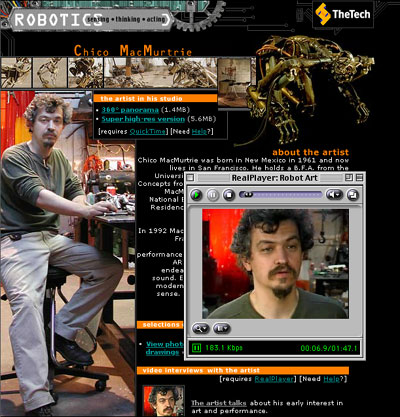
Figure 2. Robot Art
An excellent site that makes use of on-demand video is the "The Living Room Candidate "(http://www.ammi.org/livingroomcandidate). The site focuses primarily on political advertisements that ran during presidential campaigns from 1952 to 1996. The ads are presented as separate streaming video clips. Additional materials consist of a short introductory text, a larger program, an educational guide, and thumbnail images from the videos. The additional materials help explain and enhance the video, provide historical context, point out themes, and create a richer experience.
These examples use additional media elements to complement streaming video. In the case of "The Science of Hockey," for example, on-demand video is used within a text- and graphics-based story. The video is not required to tell the story. Whereas both "Robot Art" and "The Living Room Candidate" rely much more heavily on the user's ability to view streaming video. All the examples use short video clips that provide flexibility in what the user views, and in what sequence. Live Webcasts have not provided the end-user with this sort of flexibility until now. Nor has the addition of other media elements to Webcasting been focused on.
Live Webcasts
In most cases, video-on-demand is just one of a variety of media types used to tell a story. A Webcast, on the other hand, has been viewed as an end in itself. Many times little thought is given to how other media elements could enhance the Web user's experience. Considering the technical, organizational, and programmatic complexity involved in presenting live Webcasts it's not surprising. But despite the limitations of medium (poor video quality and the small window size), exploring other ways of improving the end-user's experience would seem to be the next logical step.
Figure 3. Exploratorium Eclipse Telecom/Internet Schematic. This schematic demonstrates the technical challenges involved in the most complex Webcasts.
Live Webcasts can bring the museum floor to remote visitors or remote locations to the museum and Web visitors. At the Exploratorium, the author was involved, to one degree or another, in about two dozen Webcasts. To date, the Exploratorium has presented over fifty Webcasts.
The 1999 Eclipse Webcast (http://www.exploratorium.edu/eclipse) was easily the most popular Webcast (to both Web and museum audiences) the Exploratorium ever presented. The ingredients for success largely had to do with the structure of the program. First, it presented a unique phenomenon, a total solar eclipse. Second, it presented a live video signal from an exotic remote location, in this case, Turkey. Promotion efforts and media hype about the eclipse helped drive traffic to the site. The event itself was an excellent vehicle for exploring the science and history surrounding eclipses. On the museum floor, the "Webcast" studio and surrounding areas were packed with visitors who by all accounts greatly enjoyed the Webcast. On the Web, our visitors enjoyed the event, too, but the museum visitors a more universally favorable impression.
In 1999, the Exploratorium produced a Webcast on the Science of Chocolate (http://www.exploratorium.edu/chocolate) for Valentine's Day. The event was hugely popular on the museum floor. Well over 500 people visited and the museum sold a record number of museum memberships; but on the Web, the event was not as popular as anticipated. For obvious reasons, meeting scientists, pastry chefs, and chocolatiers, and getting to sample chocolate was much more appealing to museum visitors than to Web visitors. In addition, museum visitors seemed to enjoy the two-hour format, but Web visitors didn't stick around to watch the entire show. Similar criticism was offered from some Web visitors about the length of the Eclipse Webcast, which was also two hours in length.
Just how long a Webcast should be is a difficult question to answer. The average duration of a Web visit to the educational resources examined in "Who's Out There? A Pilot User Study of Educational Web Resources" was about eight minutes. Webcasting can hold visitors' attention for longer periods of time, but at the Exploratorium, the number of viewers frequently dropped off during the course of a broadcast.
Another factor is how people use their computers. Few people regularly use their computers to view lengthy movies or TV shows (even when they can fill the entire screen, which DVD players can do). Generally, computers are used in active ways, working, surfing, clicking around--it's a lot to ask of a viewer, to sit at a computer for two hours and just watch the screen, particularly when the size of the video window is so small.
Almost every Webcast I've been a part of has worked very well as a museum event. Visitors to the museum floor can communicate with each other and with scientists or other guests; they can watch videos or demonstrations, and interact in other ways. If the presentation on the Web could somehow be more dynamic, perhaps by injecting other types of media, or by somehow involving users more actively in the Webcast, they might stick around longer and the experience might be richer. In other words, perhaps there is a way to replicate the qualities of the museum experience for remote Webcast viewers.
In retrospect, the "Webcast pages" for the Eclipse and Chocolate events could have been much more dynamic. Both pages work in the same way (and in fact, are similar to most other Exploratorium Webcast pages). The user clicks on a link launching an external player that shows the video. These pages took a great deal of time to develop, making sure that links to "help pages" were easy to find, linking to other resources, and creating a "look and feel" that enhanced the presentation of the topic. The problem with the design is one of function rather than one of form.
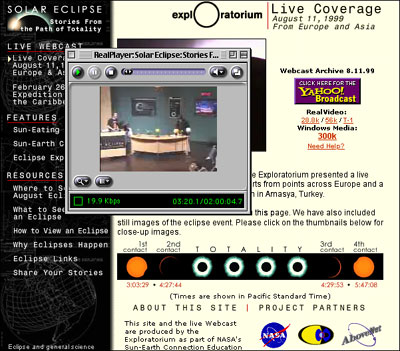
Figure 4. Solar Eclipse Page. The Exploratorium's Solar Eclipse Webcast page hosted by Yahoo! Broadcast.
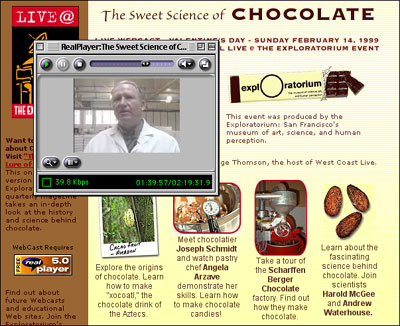
Figure 5. The Exploratorium's Sweet Science of Chocolate Webcast Page.
Both sites contain images and text-based information that provide background information and create a context for the Webcast. Additional resources greatly add to the visitor's experience. They could generate anticipation for events yet to come, and provide some longevity to the sites, bringing visitors back well after the excitement of live events has dissipated. This approach was developed while experimenting with on-demand video.
Unfortunately, there was never the time to develop a method to allow visitors to browse these resources (or to "push" additional media types) during a live event. Here's what would happen: When a Webcast viewer wanted to explore these additional resources, their video window would disappear behind the browser window. These resources could be used before or after the event--but not during. Unlike sites that use on-demand video, you'll miss some of the live Webcast program if you try to view these additional materials.
Both the Eclipse event and the Sweet Science of Chocolate did allow users to email questions, which provided a limited feedback mechanism. A better method was chat areas, but again these were separate links that if clicked on sent the user's video window behind the browser window. For many visitors the Webcast experience was a solitary one, with no interaction with other visitors or with the producers or guests of the event.
The Webcast Viewer: A Possible Method For of Presenting Live Video
Most Webcasting examples work in similar ways to the Exploratorium Webcast pages. The focus has been primarily on the video stream itself. Rarely have museums experimented with two-way communication such as chat or messaging during Webcasts. Keeping in mind how most Web visitors seem to use their computers, I've given some thought to an alternative way of presenting museum Webcasts, one that would make additional materials available and that could incorporate user participation and interaction, all of this while not interrupting a continuous program stream.
Some streaming media service providers and Application Service Providers (ASPs) have or are in the process of developing custom interfaces for business presentations. For example, Presenter.com (http://www.presenter.com) uses a pop-up window that allows the user to view a video stream and slide presentation. Obviously, for business presentations, this is a must. Certainly the addition of a similar feature could help enhance museum Webcasts for Internet audiences.
An interesting real-time messaging system called SPARC (Space Physics & Aeronomy Research Collaboratory (http://sparc-1.si.umich.edu/sparc/central/page/SPARC) deserves mention, too. It enables Web visitors to chat on a page in real-time. On the site, others who are visiting the page are visible, either as guests (with no chat abilities) or as registered users (with the ability to chat). This is similar to popular sites that use Java IRC.
Inspired by these interesting examples, the author has developed a mock-up of a proposed "Webcast Viewer." It incorporates the slide area and a messaging feature, along with an embedded video window into a pop-up browser window. Frames are used to present the different features within the window.
Figure 6. The " Webcast Viewer"
The embedded video screen can support a variety of connection speeds. The mock-up incorporates a Windows Media player, but RealMedia or QuickTime could be used instead.
There is an area for slides or text, a window that could support any HTML document. A scrolling feature could also be added. A "zoom" feature could be used to allow visitors to examine details of the materials presented. An "edit" feature would allow users to set preferences such as image types or sizes. Additional links (which appear as "Slide 1" etc.) could permit users to browse slides, or the slides could be "pushed" automatically as the Webcast proceeded. This could be done with a CGI (Common Gateway Interface) script, Javascript, or Java applet. Thumbnails of the images could also be used within the window.
The slide area could provide space for animations, or even applications. Obviously, this would require additional resources for development. Flash, Shockwave, or Java technology could be used. This route would require that the end-user have the proper browser or plug-ins to view or interact with the file, but it could certainly add a new dimension to a live Webcast. The real benefit of a slide area for museum presentations is that artwork or scientific charts could be shown at an adequate size for visitors to properly see the details.
The bottom of the figure contains a Webcast messaging frame that allows users to chat with other visitors and/or museum personnel. Registered users would have chat privileges while unregistered user could "lurk," that is, observe the chat without participating. The "edit" feature would allow users to change their names and/or other information. The chat area could be moderated, although registration would provide a degree of protection from unwanted graffiti.
The window would serve the important purpose of displaying the number of individuals who are tuned in to the Webcast. Currently, viewing is a solitary experience with no indication that others are watching or viewing the event with you. During small events visitors could chat and carry on conversations about the topics presented by Webcast. With large-scale events it would very difficult to carry a conversation, but viewers might be able to influence the direction of the Webcast with their comments, which also might be of interest to other online visitors.
Technical Issues
The technology exists to create a working version the Webcast Viewer presented. (It should be mentioned that this was not always the case. The "embedded" video screen was not well supported on some platforms and with some older versions of browsers.) The Webcast viewer simply combines a number of existing technologies in one pop-up browser window using frames.
The question of bandwidth is a tougher one to answer. Sending additional text and/or images may interrupt streams for some users connected at slower speeds. Webcast streams bit rates may need to be reduced to allow for more "overhead," insuring that the viewer could receive additional media without interrupting the continuous stream. In addition, the "edit" options for both the slide and message features could contain preferences to limit the size or the number of times the screens "refresh." Another approach might preload slides or images allowing users to store them locally before the Webcast begins.
The Archive
Most Webcasts are archived, leaving an on-demand clip usually of the entire presentation. With the Webcast Viewer, archives could be shown in much the same way the live broadcasts were. School groups or other organizations could visit the archive at the same time using the built-in messaging system to communicate during their visit.
Conclusion
Resources that are flexible and that give visitors choices in how they interact with streaming media seems to work best. Multiple media types provide the user with options on how to use the resource and work around the technical limitations that many users have in viewing streaming media. Webcasting is much more technically and programmatically complex than producing on-demand clips. While Webcast events have been very successful on the museum floor, informal feedback suggests that the experience on the Internet has been mixed.
On the floor, visitors can interact with each other and can watch a variety of demonstrations that are occasionally presented simultaneously. As a possible solution, the Webcast Viewer attempts to incorporate some of the features that make "in person" museum Webcast events so appealing, by creating a multimedia experience and providing the potential for user interaction. Some of these qualities are the same ones that seem to work in presenting on-demand video. The Webcast Viewer could present users with choices, making Webcasts more interactive and more compelling.
The reality is that, from a technical standpoint, streaming media is not going be "TV quality" any time soon. While the promise of broadband will eventually change the situation, it will be years before Webcasting can compete with television and even then it will not be universally implemented. Recognition of this went into thinking about how the Webcast Viewer might be designed. Incorporating additional media elements and some sort of a "two-way" mechanism will surely enrich the visitor experience. Otherwise the Internet is just a broadcast medium and not a very robust one at that.
The Webcast Viewer is that it could be used as a "turn-key" solution--used over and over again to support a variety of Webcasts and topics. ASPs like Presenter.com are trying to do just that, mostly for business applications. The design and technical specifications of the Webcast Viewer could be modified and improved after each broadcast.
Perhaps as more museums begin to experiment with Webcasting, new approaches will be developed. In the last two years, several museums have conducted Webcasts, among them the Canadian Museum of Civilization (http://www.civilization.ca/membrs/theatre/iqqaip1e.html), the Franklin Institute (http://webevents.broadcast.com/unisys/fi042700/register.asp), the Denver Museum of Natural History (http://event.webcasts.com/dmnh2000/event.html), and the Cleveland Museum of Art (http://www.clevelandart.org/byzantine/webcast.htm). It will be exciting to see what the next few years will bring, as more museums venture into this arena.
The Webcast Viewer is just one way of visualizing what could be done to make Webcasting more appealing to museum Web visitors. Any method for delivering other types of media along with a video stream would help make the experience for online visitors more informative and more exciting. Taking advantage of the unique two-way nature of the Internet would help make Webcasts a more engaging, less solitary experience for remote museum visitors. The technical elements to make this possible are already out there. Perhaps it's time to begin the experiment.

